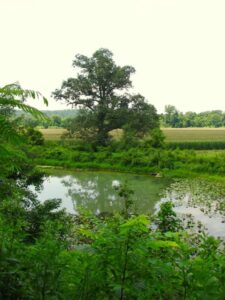
In choosing a subject to paint I often find I’m drawn to water.
Of all the elements we find in the landscape it is the one that pulls at my creative heart. Perhaps it is because it is life-giving. Or maybe it’s the ever-changing reflections on the surface that challenge me.
Next on my list would be trees and the majesty they bring to a scene. Especially here in Middle Tennessee where I make my home. The incredible variations of hardwoods in our forest are forever giving the artist a lush background in spring and summer before changing into their glorious fall garments. The soft Tennessee winter creates a ghostly gray scene, bare of leaves but full of painting possibilities.
When I can find a scene where both subjects are equal in their appeal, there I find joy.

Near my family farm is such a scene. It’s a spring-fed pond filled with lily pads and bullfrogs. Standing guard over this life-giving pond is a very large white oak tree. Likely over a hundred years old. It is separated from the distant hills by a cornfield which creates a perfect backdrop for sky holes.
Those tiny brush strokes that bring life to trees and allow the viewer to see past the mass of leaves into the light beyond.
The challenge was to paint the majesty of this ancient tree while still paying homage to its reflections.
I always do several sketches first to determine the best design for my painting. On this one, I chose to cool my palette a bit from the photograph. My reason was to reflect the coolness of the place. The composition also allows the viewer to feel the towering presence of the tree as though it has no limit to its height.
It’s important to me to try and express through paint the qualities of the scene that captured my heart. A very great teacher and landscape painter I know, once asked me “is it worth painting” when I was struggling with choosing what to paint. His question still helps me to calm my enthusiasm as I stand in a landscape and try to determine what it is I want to convey. This particular painting is from a very remote part of my state. A forgotten backroad to nowhere but very dear to me. Years past I had accompanied my Father to a cattle sale somewhere out past Beaver Dam valley. It was on this drive that we came upon this pond and both remarked at how beautiful it was. This was a time before I was a painter, but deep inside me, the landscape was calling.
Feeling connected to my subject is crucial. The sheer beauty of the scene, it’s history or simply how the light is illuminating it makes a painting possible.
To start I paint in plein air.
My first encounter with plein air began with a group of local painting enthusiasts called The Chestnut Group, a nonprofit alliance of landscape artists and friends dedicated to the conservation and preservation of vanishing landscapes in Middle Tennessee. This amazing group boasts several OPA and OPAM members. Its influence has been monumental to my growth as an artist. If you don’t already belong to a painting group, put it on your list.
Here is a list of things I try to do whenever I paint plein air…
Step into the scene… walk around it.
Be still awhile and let the light reveal its patterns
Take time with the shadows … they support the light… without them properly painted the painting will be void of life

Wait for nature to settle back undisturbed by my intrusions
Sketch, sketch, sketch
Mark the canvas with horizon lines…tick marks and perspective lines
Mass in the masses…
Correct the dark values… I always go too dark at first
Breathe…
Step back
Paint the mid tones
Establish the patterns
Place the lights!
I try to only use photos as structural references in my paintings. The small pieces painted from life give me a truer impression of what I witnessed in the field.
Favorite quotes from painters I’ve studied with or those whose work still speaks from years past run through my mind. I keep them in a small journal within my backpack for quick inspiration.
If you are new to painting my humble advice would be first visit local galleries. Search out the artists’ work that speaks to your creative spirit.
If they teach take their workshops. Paint as much as you can. Read about painting during the times you can’t paint. Study the masters. Their works are all online.
“I hope this is modest enough: because there is no subject on which I feel more humble or yet at the same time more natural. I do not presume to explain how to paint, but only how to get enjoyment.”
Winston S. Churchill, Painting as a Pastime


Leave a Reply